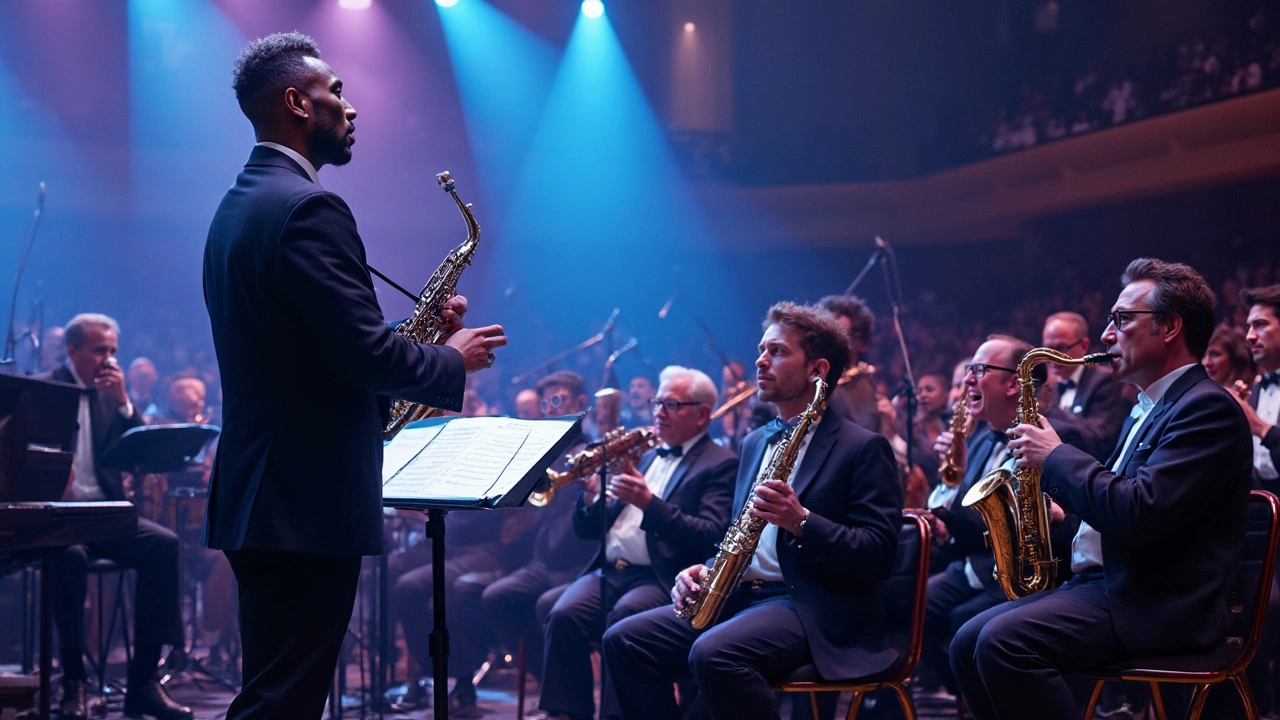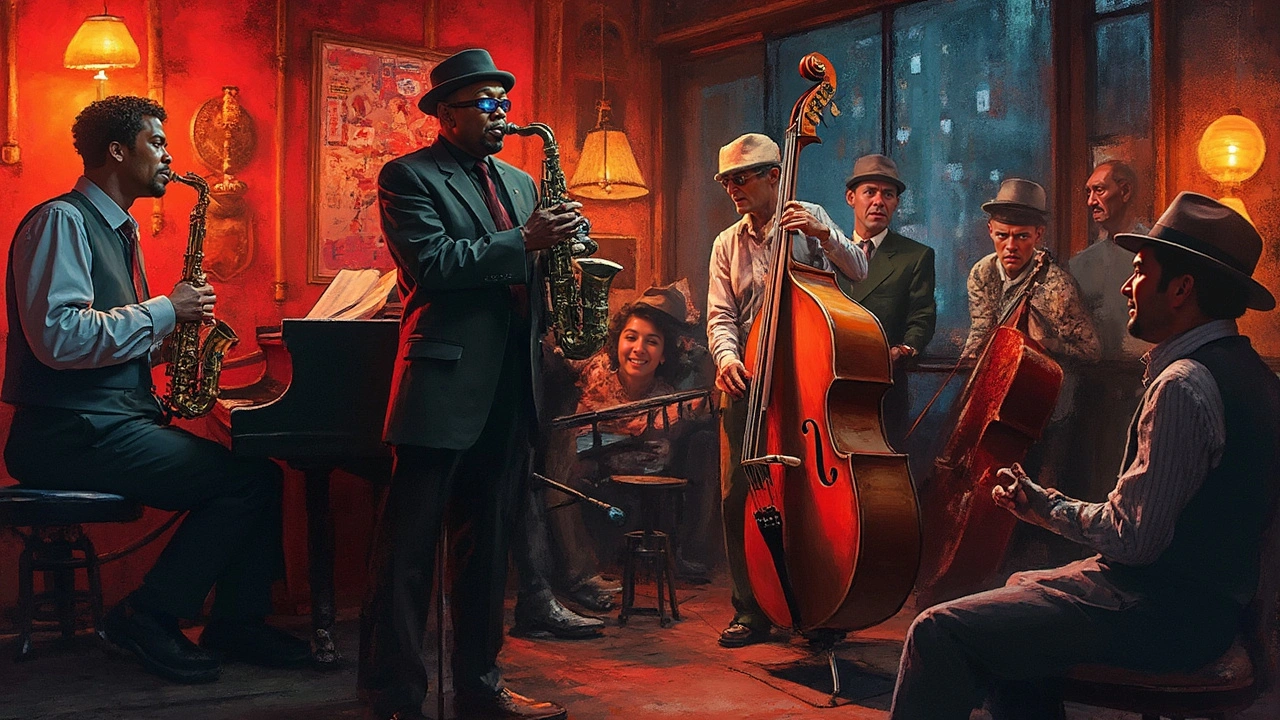Jazz music is a world of its own. It's raw, spontaneous, and full of life. If you've ever listened to jazz and found yourself swaying to its rhythms, you're not alone. But what really sets jazz apart from other music genres? It's all about improvisation. Unlike many music styles where musicians play from a set score, jazz encourages creativity and personal expression. This means that every performance can offer something new, giving musicians the freedom to explore their musical identity.
A quick dive into the past shows jazz's birth in the early 20th century in the United States, deeply rooted in African American culture. Over the years, it's picked up influences from blues, ragtime, and European classical music. New Orleans is often dubbed the 'cradle of jazz', where you could find musicians playing in street parades and bars, spreading this dynamic sound.
- What Makes Jazz Unique
- A Brief History of Jazz
- Iconic Jazz Musicians
- How Jazz Influences Modern Music
- Tips for Exploring Jazz
What Makes Jazz Unique
Jazz music isn't just another genre; it's an experience. At its heart, jazz is about spontaneity and interaction. Musicians don't just play their instruments; they have conversations through their music. This is what we often refer to as 'improvisation', and it's the magic that distinguishes jazz from other styles.
Improvisation: The Heartbeat of Jazz
Improvisation is what makes jazz so dynamic. In a jazz performance, musicians often start with a main theme. Once established, they embark on a journey of musical exploration, crafting solos in the moment. This means that every performance is one-of-a-kind, influenced by the musicians' mood and audience energy.
Syncopation and Rhythm
Another element making jazz unique is its rhythm. Jazz doesn't stick to a predictable beat; instead, it uses something called syncopation, where the rhythms are unexpected and sometimes off-beat. This gives jazz its characteristic bounce and swing. If you notice your foot tapping or your head bobbing when you listen, syncopation is the likely culprit.
The Role of Instruments
Jazz embraces a wide range of instruments, from trumpets and saxophones to pianos and drums. Each has a voice, adding to the overall texture. The beauty is in how these instruments complement each other, with solos that allow each musician's creativity to shine.
| Instrument | Role in Jazz |
|---|---|
| Trumpet | Often leads with melodies |
| Saxophone | Adds warmth and depth |
| Piano | Creates harmony and rhythm |
| Drums | Maintains the beat and adds intensity |
Interaction and Collaboration
Finally, jazz is all about interaction. Musicians listen to each other, responding in ways that enhance the overall performance. It’s like an on-stage conversation, where each contribution is valued and shapes the direction of the music.
These elements come together to create a sound that's constantly evolving, making jazz a unique and thrilling musical adventure.
A Brief History of Jazz
Jazz music has a fascinating origin story that traces back to the early 1900s in the United States. Its roots are deeply embedded in African American communities, drawing from a mix of African rhythms, blues, and ragtime. The melting pot of cultures in areas like New Orleans played a crucial role in shaping this vibrant music style.
New Orleans is often credited as the birthplace of jazz. In this bustling city, a blend of cultures, from French to Spanish, mixed with African musical traditions. Jazz started to take form in local bars, dance halls, and street performances. Musicians like King Oliver and his Creole Jazz Band were among the pioneers pushing jazz forward.
As the 1920s approached, commonly known as the 'Jazz Age,' this genre gained immense popularity. It traveled north to Chicago and New York, where legends like Louis Armstrong and Duke Ellington left their mark. These artists introduced the world to the contagious energy and inventiveness of jazz, making it a vital part of American music culture.
Key Developments in Jazz
- The 1940s saw the birth of Bebop, a more complex and fast-paced version of jazz. Charlie Parker and Dizzy Gillespie were key figures in this jazz evolution.
- During the 1950s and 1960s, jazz continued to evolve with the emergence of styles like Hard Bop, Cool Jazz, and Free Jazz.
- Today, jazz is a global phenomenon, influencing various music genres and bringing together people from diverse backgrounds.
Jazz music's timeline is a testament to its adaptability and relentless spirit. From its humble beginnings in New Orleans to its impact on modern music, jazz remains a symbol of creativity and cultural expression.
Iconic Jazz Musicians
When it comes to jazz music, the genre boasts a roster of legends who have left an indelible mark. One name that instantly pops up is Louis Armstrong. Known for his raspy voice and magnificent trumpet skills, Armstrong redefined jazz with his unique style and charisma. His recordings like 'What a Wonderful World' and 'La Vie En Rose' continue to touch hearts worldwide.
Then there's Ella Fitzgerald, the 'First Lady of Song.' Her remarkable ability to swing and scat captured the world's attention. Songs like 'Summertime' and 'Mack the Knife' showcase her versatile range and vocal flexibility. She was truly a trailblazer for music and musicians everywhere.
Another giant worth mentioning is Duke Ellington. As a bandleader, pianist, and composer, his compositions like 'Take the A Train' still resonate with jazz aficionados. What sets Ellington apart is his ability to seamlessly blend orchestrated sounds with brilliant improvisation.
Miles Davis - The Innovator
Miles Davis is often regarded as the pioneer who constantly reinvented jazz music. With albums like 'Kind of Blue' and 'Bitches Brew', he pushed musical boundaries and played a pivotal role in developing new jazz styles, such as modal jazz and jazz fusion. His influence on the genre is unmatched and continues to inspire countless musicians.
Let's not forget John Coltrane, a saxophonist known for his intense improvisations and complex compositions. He was a central figure in the development of free jazz, and his album 'A Love Supreme' is celebrated as a landmark in the history of jazz.
| Musician | Key Contribution |
|---|---|
| Louis Armstrong | Innovative trumpet techniques, entertaining vocals |
| Ella Fitzgerald | Sophisticated swing and scat singing |
| Duke Ellington | Integration of orchestral sounds |
| Miles Davis | Advancement of multiple jazz styles |
| John Coltrane | Complex improvisations, free jazz development |
These iconic figures made jazz what it is today. Each of them brought something unique to the table, influencing not just the jazz scene but music around the world.
How Jazz Influences Modern Music
It's amazing how much jazz music has shaped today's music world. If you listen closely, you can hear jazz's fingerprints in various modern genres. Artists across pop, rock, and even hip-hop often borrow techniques from jazz, whether it's the improvisational flair or those complex rhythms.
Jazz music brought improvisation to the forefront. This freedom to experiment isn't confined to jazz alone—it's found in rock guitar solos and rap freestyle battles, proving how jazz opened doors for creative expression.
Breaking Conventional Limits
In modern music, artists often break away from traditional song structures. Thanks to jazz's influence, they play with tempo, time, and harmonies. A great example is Radiohead. Listen to their work, and you'll notice unexpected time signatures and unpredictable progressions much like in jazz.
Fusion of Genres
Jazz genres like jazz fusion show how seamlessly it blends with other types of music. Bands like Snarky Puppy marry jazz with funk, rock, and R&B, creating a palette of sounds that many modern musicians aspire to.
Influence on Technology and Production
Jazz’s impact on technology is worth mentioning too. The development of recording techniques in the jazz era paved the way for what studios use today. The microphone placements for capturing those lively jazz jams play a big part in current recording practices.
Music is an evolving art form, and jazz history shows how past influences impact new sounds. Next time you hear your favorite song, think about the jazz elements that might be hidden inside. It’s like spotting Easter eggs for music lovers!

Tips for Exploring Jazz
Diving into the world of jazz music might feel a bit overwhelming at first, but it’s totally worth it. Whether you're a total newbie or someone looking to deepen their appreciation, here are some practical tips to guide your journey.
Start with the Classics
One of the best ways to get into jazz is by starting with the timeless classics. Artists like Louis Armstrong, Duke Ellington, and Billie Holiday shaped the genre with their unique styles. Try listening to Armstrong's "What a Wonderful World" or Ellington's "Take the A Train" to get a feel of the vibrant history of jazz.
Attend Live Jazz Performances
Seeing jazz live is a whole different ball game. The energy of a live performance, the interactions between musicians, and the spontaneous improvisations are experiences you can’t capture in a recording. Check out local jazz clubs or festivals to see how musicians bring jazz music to life.
Explore Different Jazz Subgenres
Jazz isn’t just one sound; it has branched into various subgenres. From bebop to fusion to smooth jazz, each has its unique flavor. Maybe smooth jazz with its laid-back vibes suits you, or perhaps the complex melodies of bebop pique your interest. Exploring different subgenres can help you find what resonates with you.
Learn to Appreciate Improvisation
Improvisation is the heart of jazz. It’s about spontaneous creativity, where musicians take turns to solo and express themselves. Listening to live jazz, you'll notice how each performance is unique. Try focusing on the solos, and you'll begin to appreciate the skill and creativity behind it.
Join a Jazz Community
Being part of a community can enhance your appreciation for jazz—whether it's a local group or an online forum. Engaging with others who share your interest can offer fresh insights, recommendations, and even discussions on jazz music history and influential albums.
If you're curious about the current jazz scene, here’s a quick glance at jazz album sales from the past few years:
| Year | Album Sales |
|---|---|
| 2022 | 1.2 million |
| 2023 | 1.5 million |
| 2024 | 1.7 million |
See those numbers rising? It’s clear that even today, jazz continues to capture the hearts of many. So, throw on a record, attend a live show, or join a community—just dive in and explore the endless tapestry of jazz music.

